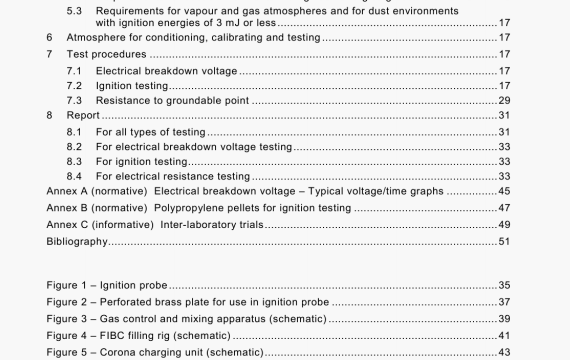ISO 61340-4-4 pdf download – Electrostatics一 Part 4-4: Standard test methods for specific applications – Electrostatic classification of flexible intermediate bulk containers (FIBC).
NOTE It is recommended that pellets be changed regularly. It is not possible to specify intervals for changing pellets, but as a guide they should be changed whenever there are obvious signs of contamination, physical degradation, when the level of tribocharging is significantly reduced, or when there is an obvious build-up of tines.
All sections of the test FIBC, including the discharging spout, shall be accessible for approach with the ignition probe.
Depending on the design of the filling rig and its location, it may be necessary to provide a working platform to support the test apparatus and personnel.
An earth connection shall be provided for FIBC that are required to be earthed during normal use.
For FIBC that are not required to be earthed during normal use, insulation shall be inserted between the lifting loops and the support points on the metal framework, such that the resistance to earth shall be at least 1012 fl
All metal support framework, working platforms and any other conductors, including personnel, within 1 m of the test FIBC shall be earthed, irrespective of the type of FIBC being tested.
7.2.1.4 Charge measuring apparatus
The charge measuring apparatus comprises two main parts: a Faraday pail for collecting charged pellets and a means of measuring the charge flowing into the Faraday pail. It Is convenient to use a conductive FIBC as a Faraday pail. The FIBC shall be constructed entirley from conductive material or at least shall contain fully inter-connected conductive threads or tapes with a maximum spacing of 20 mm if the threads or tapes are in a stripe pattern or 50 mm if they are in a grid pattern. The resistance to groundable point of the FIBC shall be less than 108 fl when measured according to 7.3.
An electrometer Is used to measure the charge flowing into the conductive FIBC. The electrometer shall either have an average, minimum and maximum function or shall have a suitable signal output from which the average, minimum and maximum charging current can be determined by means of a suitable instrument (e.g. digital multimeter, oscilloscope, data logger, etc.).
7.2.2 Establishing correct charging current
Mount the conductive FIBC (7.2.1.4) in the filling rig (7.2.1.3) ensuring that the resistance from the conductive FIBC to the filling rig, or from the conductive FIBC to any other earth connection, is at least 1012 j
Connect the electrometer (7.2.1.4) to the groundable point on the conductive FIBC and connect the electrometer to ground. If a separate averaging instrument (7.2.1.4) is to be used connect it to the electrometer.
Begin pellet flow of (1,1 ± 0,1) kg/s into the FIBC and apply desired voltage to the pellet corona charging system.
Once the bottom of the FIBC is filled with pellets and a consistent cone of pellets has been formed, proceed with performing average measurements.
7.2.3 Ignition tests
Ignition tests are carried out by bringing the ignition probe (7.2.1.1) up to the wall of the charged test FIBC with the flammable gas mixture flowing through the probe. The following test sequence is designed to produce at least 200 ignition tests on the test FIBC. The test sequence may be terminated at any time after a single verifiable ignition has occurred, the test FIBC having failed to meet the requirements specified in 5.3.
NOTE It may be desirable to continue testing even when a single ignition has occurred.
It may be necessary to fill and empty the test FIBC several times in order to complete the required number of ignition attempts. For FIBC without an outlet, a suitable size cut shall be made in the base. In this case It may be necessary to use several FIBC of the same design and size in order to complete the full test sequence.
The whole sequence of ignition attempts is made on each of the four walls of the test FIBC (50 ignition attempts on each wall). Additional ignition attempts (10 on each panel) shall be made on any panel attached to the test FIBC (e.g. flaps covering spouts), on any panel that differs substantially in its construction compared to the rest of the test FIBC and on any label or document pouch greater than 100 cm2 in area. Labels and document pouches less than 100 cm2 and lifting straps do not need to be tested.
By arrangement between interested parties, ignition attempts may be made at other locations in addition to those specified in this standard. In such cases the position of additional measurement points shall be described In the test report.
ISO 61340-4-4 pdf download – Electrostatics一 Part 4-4: Standard test methods for specific applications – Electrostatic classification of flexible intermediate bulk containers (FIBC)
